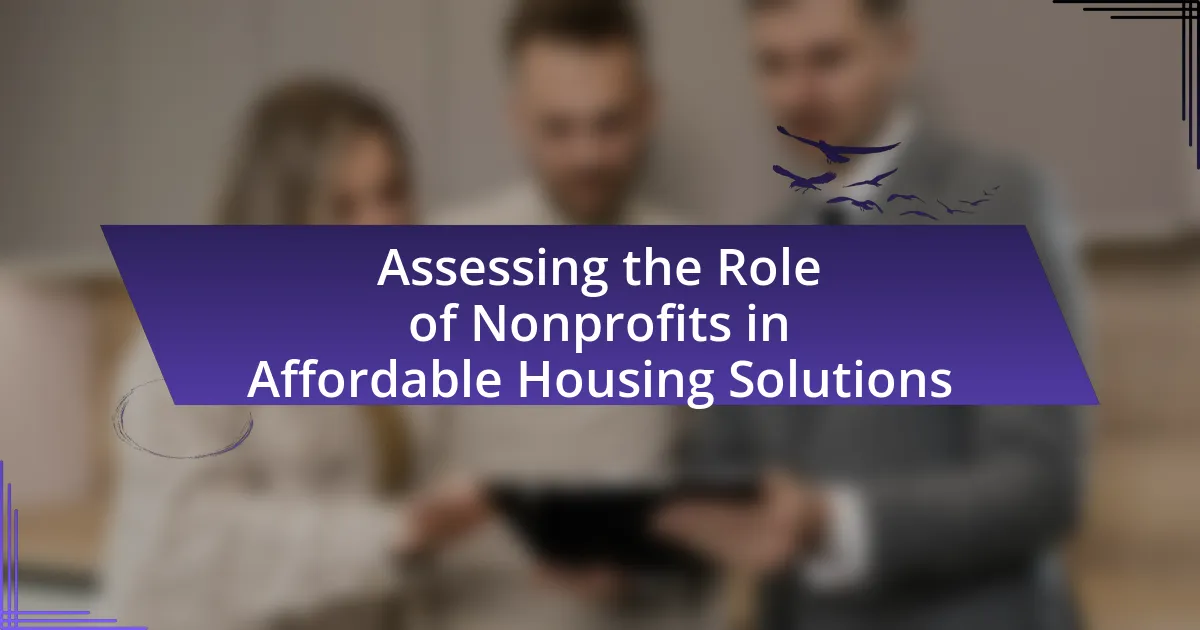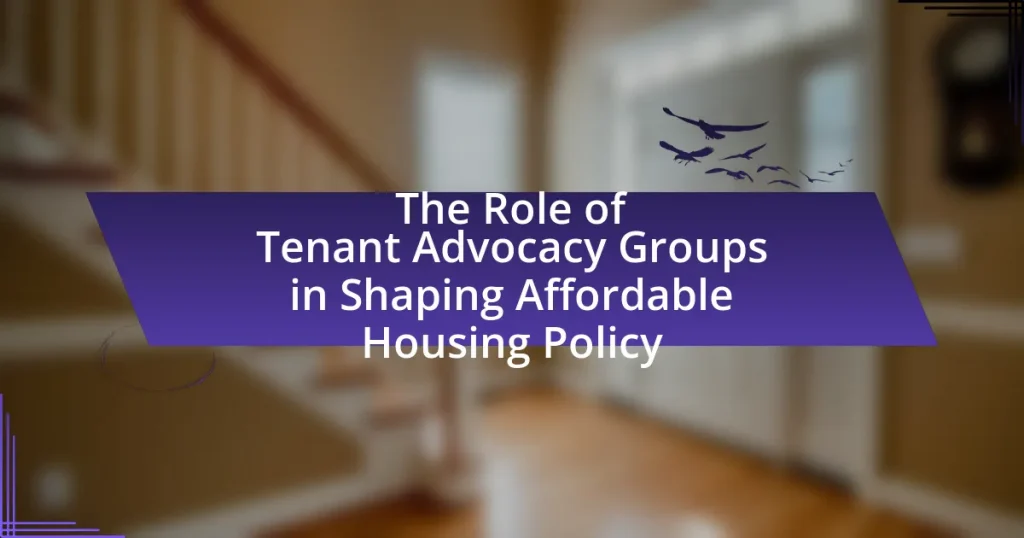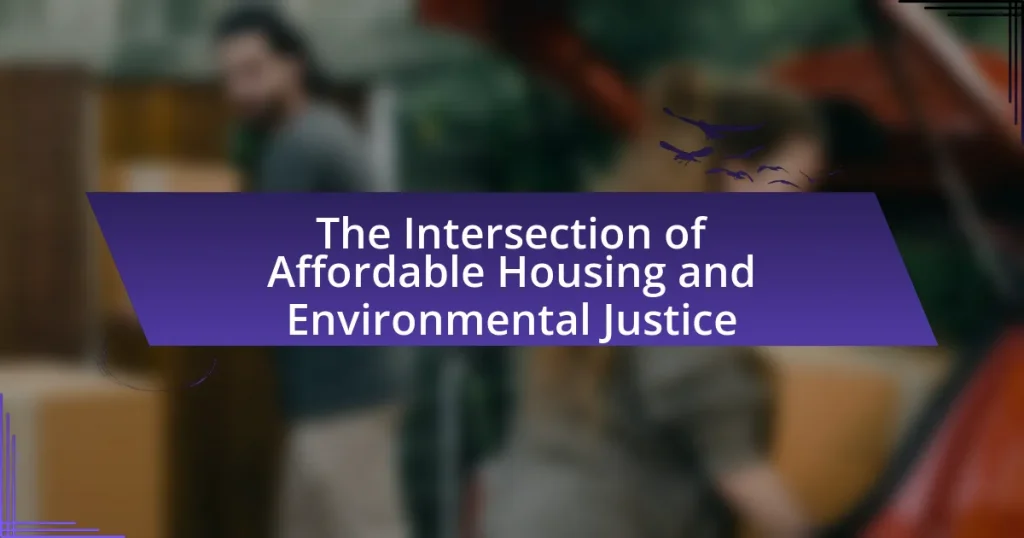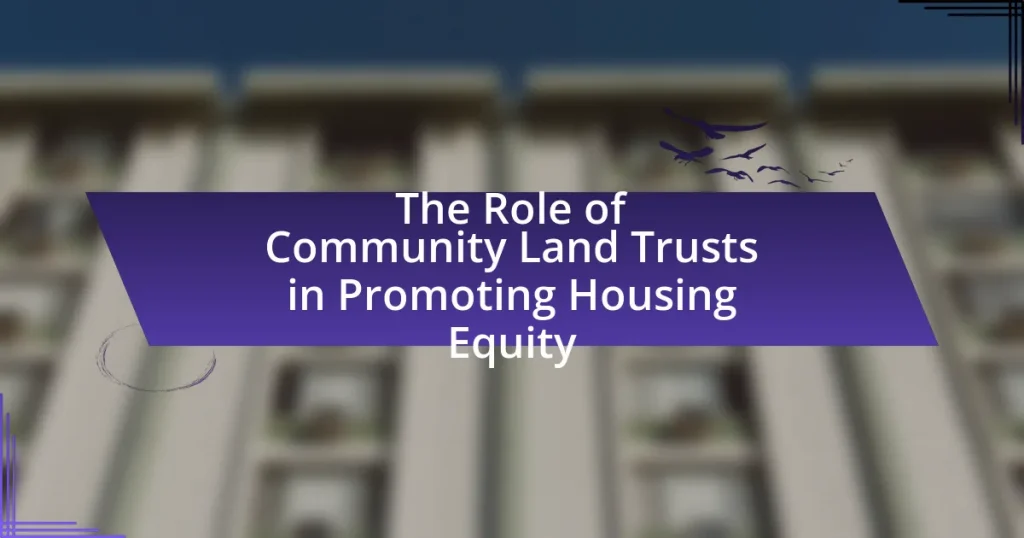Nonprofits play a vital role in addressing affordable housing solutions by developing, financing, and managing housing projects for low-income individuals and families. They leverage public and private funding, advocate for policy changes, and provide essential support services, contributing to the creation of over 1.5 million affordable housing units in the United States since 1990. The article explores the various ways nonprofits engage in affordable housing development, the specific programs they implement, their collaborations with other stakeholders, and the unique advantages they hold over for-profit entities. Additionally, it examines the impact of nonprofit housing initiatives on communities and local economies, the challenges they face, and the best practices they should adopt to enhance their effectiveness in providing sustainable housing solutions.

What is the role of nonprofits in affordable housing solutions?
Nonprofits play a crucial role in affordable housing solutions by developing, financing, and managing housing projects that cater to low-income individuals and families. These organizations often leverage public and private funding, including grants and donations, to create housing opportunities that would otherwise be inaccessible due to market constraints. For instance, according to the National Low Income Housing Coalition, nonprofits have been instrumental in producing over 1.5 million affordable housing units in the United States since 1990. Additionally, nonprofits often advocate for policy changes and provide support services, such as financial counseling and job training, which further enhance housing stability for vulnerable populations.
How do nonprofits contribute to the development of affordable housing?
Nonprofits contribute to the development of affordable housing by engaging in various activities such as funding, advocacy, and direct construction. These organizations often secure grants and donations to finance housing projects, enabling them to build or rehabilitate homes for low-income families. For instance, the National Low Income Housing Coalition reported that nonprofits play a crucial role in leveraging public and private funds, which can lead to the creation of thousands of affordable housing units annually. Additionally, nonprofits advocate for policies that support affordable housing initiatives, influencing local and national legislation to increase funding and resources for housing development. Their multifaceted approach not only addresses immediate housing needs but also fosters long-term community stability and growth.
What specific programs do nonprofits implement to address housing needs?
Nonprofits implement various specific programs to address housing needs, including affordable housing development, emergency shelter services, and housing assistance programs. For instance, organizations like Habitat for Humanity focus on building affordable homes for low-income families, while the National Alliance to End Homelessness provides resources for emergency shelters and transitional housing. Additionally, programs such as rental assistance and housing vouchers, often funded through government partnerships, help individuals secure stable housing. These initiatives are supported by data indicating that nonprofits play a crucial role in reducing homelessness and increasing access to affordable housing, with studies showing that nonprofit housing developments often serve populations that traditional market solutions overlook.
How do nonprofits collaborate with other stakeholders in housing initiatives?
Nonprofits collaborate with other stakeholders in housing initiatives by forming partnerships with government agencies, private sector developers, and community organizations to leverage resources and expertise. These collaborations often involve joint funding efforts, where nonprofits secure grants and donations to support housing projects, while stakeholders provide technical assistance and regulatory support. For instance, the National Low Income Housing Coalition reports that successful collaborations can lead to the development of affordable housing units, as seen in initiatives like the Low-Income Housing Tax Credit program, which incentivizes private investment in affordable housing. This synergy enhances the effectiveness of housing initiatives, ensuring that diverse needs are met and resources are utilized efficiently.
Why are nonprofits essential in the affordable housing sector?
Nonprofits are essential in the affordable housing sector because they address gaps in housing availability and affordability that the private market often overlooks. These organizations mobilize resources, advocate for policy changes, and develop housing projects that cater to low-income populations. For instance, according to the National Low Income Housing Coalition, there is a shortage of 7 million affordable rental homes for extremely low-income renters in the United States. Nonprofits play a critical role in bridging this gap by providing services such as housing counseling, financial assistance, and community development initiatives, which are vital for creating sustainable and inclusive housing solutions.
What unique advantages do nonprofits have over for-profit entities?
Nonprofits have unique advantages over for-profit entities primarily due to their mission-driven focus, which prioritizes social impact over profit maximization. This focus allows nonprofits to access funding sources such as grants and donations that are not available to for-profit organizations. For example, in the affordable housing sector, nonprofits can secure government grants and philanthropic contributions aimed at community development, enabling them to provide housing solutions at lower costs. Additionally, nonprofits often benefit from tax-exempt status, which reduces operational costs and allows them to allocate more resources toward their mission. This combination of funding opportunities and cost advantages positions nonprofits to effectively address community needs in ways that for-profit entities may not be able to achieve.
How do nonprofits address the challenges of affordable housing?
Nonprofits address the challenges of affordable housing by developing, managing, and advocating for affordable housing solutions. They often engage in building new housing units, rehabilitating existing properties, and providing supportive services to low-income families. For instance, organizations like Habitat for Humanity construct homes for those in need, utilizing volunteer labor and donations to keep costs low. Additionally, nonprofits often collaborate with government agencies to secure funding and resources, such as the Low-Income Housing Tax Credit, which incentivizes private investment in affordable housing. These efforts are crucial, as the National Low Income Housing Coalition reports that there is a shortage of 7 million affordable rental homes for extremely low-income renters in the United States.
What impact do nonprofits have on communities regarding affordable housing?
Nonprofits significantly enhance communities by increasing access to affordable housing. They achieve this through various initiatives, including the development of low-income housing projects, advocacy for housing policies, and providing support services to residents. For instance, according to the National Low Income Housing Coalition, nonprofits have created over 1.5 million affordable housing units in the United States, directly addressing housing shortages and improving living conditions for low-income families. Additionally, nonprofits often collaborate with local governments and private sectors to leverage funding and resources, further amplifying their impact on community stability and economic growth.
How do nonprofit housing initiatives affect local economies?
Nonprofit housing initiatives positively impact local economies by increasing affordable housing availability, which in turn stimulates economic growth. These initiatives often lead to job creation during construction and ongoing property management, contributing to local employment rates. For instance, a study by the National Low Income Housing Coalition found that every $1 million invested in affordable housing generates approximately 17 jobs in the construction sector and 11 jobs in the broader economy. Additionally, increased housing stability allows residents to spend more on local goods and services, further boosting economic activity.
What social benefits arise from nonprofit involvement in housing?
Nonprofit involvement in housing provides significant social benefits, including increased access to affordable housing, community development, and enhanced social cohesion. By focusing on underserved populations, nonprofits help reduce homelessness and housing instability, which is evidenced by studies showing that nonprofit housing initiatives can lower the rate of homelessness by up to 30% in targeted areas. Additionally, these organizations often engage in community-building activities, fostering a sense of belonging and collaboration among residents, which contributes to improved neighborhood safety and well-being. Furthermore, nonprofits frequently advocate for policy changes that promote equitable housing practices, thereby addressing systemic inequalities in housing access.
How do nonprofits measure their success in affordable housing solutions?
Nonprofits measure their success in affordable housing solutions primarily through metrics such as the number of housing units developed, occupancy rates, and the demographic diversity of residents served. These metrics provide quantifiable evidence of the impact nonprofits have on community housing needs. For instance, a report by the National Low Income Housing Coalition indicates that successful nonprofits often track the percentage of families that transition from homelessness to stable housing, which can be a critical indicator of effectiveness. Additionally, surveys assessing resident satisfaction and community engagement levels further validate the success of these initiatives, demonstrating how well the housing solutions meet the needs of the population served.
What challenges do nonprofits face in providing affordable housing?
Nonprofits face significant challenges in providing affordable housing, primarily due to limited funding and regulatory barriers. Funding constraints arise from reliance on donations, grants, and government support, which can be inconsistent and insufficient to meet growing housing demands. Regulatory barriers include zoning laws and building codes that can complicate or delay housing projects, making it difficult for nonprofits to navigate the approval processes. Additionally, competition for resources among various nonprofits can further strain their ability to deliver affordable housing solutions effectively. These challenges highlight the complexities nonprofits encounter in addressing the affordable housing crisis.
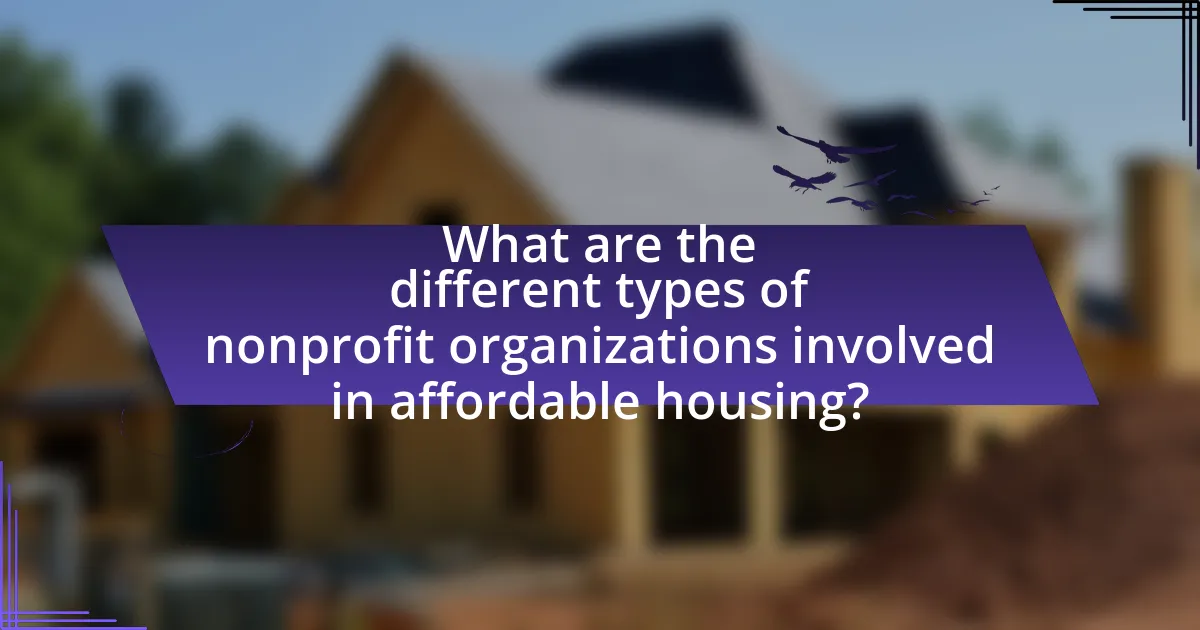
What are the different types of nonprofit organizations involved in affordable housing?
The different types of nonprofit organizations involved in affordable housing include community development corporations (CDCs), housing cooperatives, faith-based organizations, and advocacy groups. Community development corporations focus on revitalizing neighborhoods and providing affordable housing options, often through development projects. Housing cooperatives allow residents to collectively own and manage their housing, promoting affordability and community engagement. Faith-based organizations leverage their resources and networks to support housing initiatives, often addressing the needs of low-income families. Advocacy groups work to influence policy and raise awareness about affordable housing issues, pushing for systemic changes to improve access to housing. Each type plays a crucial role in addressing the affordable housing crisis by providing resources, support, and advocacy for underserved populations.
How do community development corporations operate in the housing sector?
Community development corporations (CDCs) operate in the housing sector by developing, rehabilitating, and managing affordable housing projects to meet the needs of low- and moderate-income communities. These organizations typically engage in activities such as acquiring land, securing financing, and collaborating with local governments and other stakeholders to create housing solutions. For instance, according to the National Congress for Community Economic Development, CDCs have facilitated the construction of over 100,000 affordable housing units annually in the United States, demonstrating their significant impact on increasing housing availability.
What are the primary functions of community development corporations?
Community development corporations (CDCs) primarily function to promote economic development, affordable housing, and community revitalization. They achieve these objectives by engaging in activities such as real estate development, providing social services, and fostering community engagement. For instance, according to the National Congress for Community Economic Development, CDCs have successfully developed over 1.5 million affordable housing units across the United States, demonstrating their significant impact on housing solutions. Additionally, CDCs often collaborate with local governments and private sectors to leverage resources and enhance community infrastructure, further solidifying their role in community development.
How do community development corporations engage with residents?
Community development corporations engage with residents through participatory planning processes and community outreach initiatives. These organizations actively involve residents in decision-making by hosting workshops, forums, and surveys to gather input on local needs and priorities. For instance, a study by the Urban Institute highlights that community development corporations often facilitate neighborhood meetings to discuss housing developments, ensuring that resident voices shape project outcomes. This engagement fosters a sense of ownership and accountability, leading to more effective and tailored solutions in affordable housing.
What role do housing cooperatives play in affordable housing?
Housing cooperatives play a crucial role in providing affordable housing by enabling residents to collectively own and manage their living spaces, which reduces costs and increases stability. This model allows members to share expenses and responsibilities, leading to lower monthly housing costs compared to traditional rental markets. Research indicates that housing cooperatives can offer long-term affordability, as they are less susceptible to market fluctuations and gentrification pressures. For instance, a study by the National Cooperative Business Association found that cooperative housing can reduce housing costs by 20-30% compared to conventional housing options.
How do housing cooperatives differ from traditional housing models?
Housing cooperatives differ from traditional housing models primarily in their ownership structure; cooperatives are owned and managed collectively by their members, while traditional housing models typically involve individual ownership or rental agreements. In a housing cooperative, members purchase shares in the cooperative, granting them the right to occupy a unit and participate in decision-making processes, which fosters a sense of community and shared responsibility. This model often leads to lower housing costs and increased affordability, as profits are reinvested into the cooperative rather than distributed to external shareholders, contrasting with traditional models where profit maximization is a primary goal.
What are the benefits of living in a housing cooperative?
Living in a housing cooperative offers several benefits, including affordability, community engagement, and shared decision-making. Housing cooperatives typically have lower housing costs compared to traditional rental options because they operate on a non-profit basis, allowing residents to share expenses and resources. Additionally, residents in cooperatives often participate in governance, fostering a sense of community and collaboration, which can lead to stronger social ties and support networks. Research indicates that cooperative living can enhance residents’ quality of life by promoting stability and reducing isolation, as members work together to maintain their living environment and address common concerns.
How do faith-based organizations contribute to affordable housing?
Faith-based organizations contribute to affordable housing by leveraging their community networks, financial resources, and volunteer efforts to develop and support housing initiatives. These organizations often mobilize congregations to raise funds, provide labor, and advocate for policies that promote affordable housing. For instance, Habitat for Humanity, a well-known faith-based organization, has built over 1 million homes worldwide, demonstrating the impact of faith communities in addressing housing shortages. Additionally, studies show that faith-based organizations often collaborate with local governments and other nonprofits, enhancing their capacity to create sustainable housing solutions.
What initiatives do faith-based organizations typically support?
Faith-based organizations typically support initiatives focused on community development, poverty alleviation, and social justice. These organizations often engage in affordable housing projects, providing resources and advocacy to address housing insecurity. For instance, many faith-based groups partner with local governments and nonprofits to create low-income housing options, reflecting their commitment to serving marginalized populations. Research indicates that faith-based organizations contribute significantly to affordable housing efforts, with studies showing that they mobilize volunteers and donations effectively, enhancing community resilience and support systems.
How do faith-based organizations mobilize community support for housing?
Faith-based organizations mobilize community support for housing by leveraging their networks, values, and community trust to advocate for affordable housing initiatives. These organizations often engage in outreach programs, host community meetings, and collaborate with local governments and other nonprofits to raise awareness about housing issues. For instance, a study by the Urban Institute highlights that faith-based groups frequently utilize their congregational platforms to educate members about housing challenges and encourage collective action, resulting in increased community involvement and resource mobilization. Additionally, faith-based organizations often provide direct services, such as financial assistance or housing counseling, which further solidifies their role as key players in fostering community support for housing solutions.

What strategies can nonprofits adopt to enhance their impact on affordable housing?
Nonprofits can enhance their impact on affordable housing by implementing collaborative partnerships with local governments, private sector stakeholders, and community organizations. These partnerships enable nonprofits to leverage resources, share expertise, and create comprehensive housing solutions that address community needs. For instance, a study by the Urban Institute found that collaborative approaches can increase the effectiveness of affordable housing initiatives by 30%, demonstrating the value of collective action in addressing housing challenges. Additionally, nonprofits can adopt data-driven strategies to identify housing needs and measure the effectiveness of their programs, ensuring that their efforts are targeted and impactful.
How can nonprofits leverage partnerships for better housing outcomes?
Nonprofits can leverage partnerships for better housing outcomes by collaborating with government agencies, private developers, and community organizations to pool resources and expertise. These partnerships enable nonprofits to access funding, share best practices, and enhance service delivery, ultimately leading to more effective housing solutions. For instance, a study by the Urban Institute found that collaborations between nonprofits and local governments resulted in a 30% increase in affordable housing units developed in urban areas. This demonstrates that strategic partnerships can significantly amplify the impact of nonprofit housing initiatives.
What types of partnerships are most effective for nonprofits in housing?
Collaborative partnerships between nonprofits and local governments, private developers, and community organizations are most effective for nonprofits in housing. These partnerships leverage resources, expertise, and networks to address housing challenges. For instance, a study by the Urban Institute highlights that collaborations with local governments can enhance access to funding and streamline regulatory processes, while partnerships with private developers can lead to innovative housing solutions and increased construction efficiency. Additionally, community organizations can provide valuable insights into local needs, ensuring that housing initiatives are tailored to the specific demographics they serve.
How can nonprofits engage with local governments for support?
Nonprofits can engage with local governments for support by establishing collaborative partnerships that address community needs. These partnerships can involve joint initiatives, such as affordable housing projects, where nonprofits leverage their expertise in community engagement and service delivery while local governments provide funding, resources, and regulatory support. For instance, the National Council of Nonprofits highlights successful collaborations where nonprofits have worked with local governments to secure grants and develop policies that enhance affordable housing availability. Such engagement not only fosters mutual benefits but also aligns with local government objectives to improve community welfare and address housing shortages.
What funding sources are available for nonprofits working in affordable housing?
Nonprofits working in affordable housing can access various funding sources, including government grants, private foundations, corporate sponsorships, and individual donations. Government grants, such as those from the U.S. Department of Housing and Urban Development (HUD), provide significant financial support for affordable housing initiatives. Private foundations, like the Ford Foundation and the Robert Wood Johnson Foundation, often allocate funds specifically for housing projects. Corporate sponsorships can also be a vital source of funding, as companies may contribute to community development efforts as part of their corporate social responsibility programs. Additionally, individual donations can be solicited through fundraising campaigns and events, which are crucial for sustaining nonprofit operations in affordable housing.
How can nonprofits diversify their funding streams?
Nonprofits can diversify their funding streams by exploring multiple sources such as grants, individual donations, corporate sponsorships, and earned income strategies. For instance, according to the National Council of Nonprofits, over 30% of nonprofit revenue comes from government grants, while individual donations account for nearly 70% of private funding. Additionally, nonprofits can establish social enterprises that generate revenue through services or products related to their mission, thereby creating a sustainable income source. By leveraging these varied funding avenues, nonprofits can reduce reliance on any single source and enhance financial stability.
What role do grants and donations play in nonprofit housing initiatives?
Grants and donations are crucial for nonprofit housing initiatives as they provide essential funding to develop, maintain, and expand affordable housing projects. Nonprofits often rely on these financial resources to cover construction costs, operational expenses, and community services associated with housing developments. For instance, according to the National Low Income Housing Coalition, in 2021, federal and state grants accounted for a significant portion of funding for affordable housing projects, enabling nonprofits to serve low-income populations effectively. This financial support allows nonprofits to leverage additional resources, engage in community outreach, and implement innovative housing solutions, ultimately contributing to the reduction of homelessness and housing instability.
What best practices should nonprofits follow in affordable housing projects?
Nonprofits should prioritize community engagement and collaboration as best practices in affordable housing projects. Engaging with local residents ensures that the housing solutions meet the actual needs of the community, fostering trust and support. Collaboration with government agencies, other nonprofits, and private sector partners can enhance resource sharing and increase project viability. For instance, a study by the Urban Institute highlights that community-driven approaches lead to higher satisfaction rates among residents and better project outcomes. Additionally, nonprofits should implement sustainable building practices to reduce long-term costs and environmental impact, as evidenced by the U.S. Green Building Council’s findings that sustainable housing can lower utility expenses by up to 30%.
How can nonprofits ensure community involvement in housing projects?
Nonprofits can ensure community involvement in housing projects by actively engaging local residents in the planning and decision-making processes. This can be achieved through community meetings, surveys, and focus groups that solicit input on housing needs and preferences. Research shows that projects with strong community engagement are more likely to meet the actual needs of residents, leading to higher satisfaction and better outcomes. For instance, a study by the Urban Institute found that community-driven housing initiatives resulted in a 30% increase in resident satisfaction compared to top-down approaches. By fostering collaboration and transparency, nonprofits can build trust and encourage ongoing participation from the community.
What metrics should nonprofits use to evaluate their housing programs?
Nonprofits should use metrics such as housing stability, cost-effectiveness, client satisfaction, and community impact to evaluate their housing programs. Housing stability can be measured by the percentage of clients who maintain their housing for a specified period, indicating program effectiveness. Cost-effectiveness can be assessed by comparing the cost per client served against the outcomes achieved, such as reduced homelessness rates. Client satisfaction surveys provide qualitative data on the perceived value of services, while community impact can be evaluated through metrics like the number of individuals served and improvements in local housing conditions. These metrics collectively provide a comprehensive view of program performance and areas for improvement.
